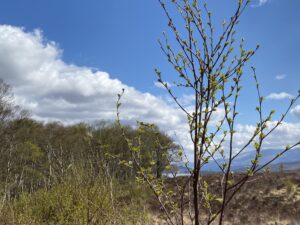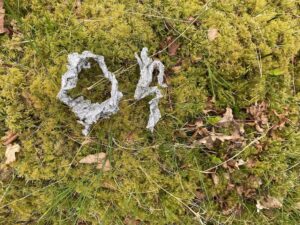From her self-seeding croft in the Scottish Highlands, Kirsteen Bell reflects on ravens and rubbish.

We are walking through the trees on the croft, my dog and I, in the first light. From over the brow of the hill, a steady stream of gulls emits from the landfill; their flight patterns whorl around the occasional pair of ravens. In my hand, I grasp a litter picker.
I walk mindfully. If I do not stick to the worn path, the stomp of my boots could be disastrous. Appearing through moss and dried curls of oak, birch, hazel, and rowan leaves, are new blaeberry shoots, the soft green hearts of wood sorrel, and the bright upturned faces of wood anemone. My collie bounds wildly up the slopes and into every dip and hollow. She helps to nose out the crisp packets, sweet wrappers, chicken bones, that I then gather into a plastic bag.
More ravens drift in from the hills on the other side of the loch, low over a tracery of oak branches. I return the gentle krrk-krrk, issued as the birds pass over my head. Tucking the litter picker into my elbow, I lift my phone to attempt a photograph and — as they always do — the ravens instantly drift away from me.
I used to think that the rubbish I found on the croft was blown from the landfill, and would mutter grumpily about poor containment, until I realised the debris was always concentrated underneath certain trees. A solitary oak growing out of an overgrown stone wall; a cluster of tall, thin birch by the west fence; a wide, solid birch by the back gate: all are regular raven perches. Singly and in pairs, the corvids gather their spoils from the landfill then come to rest on the trees here to snack, discarding what they cannot eat. Bending to wrestle a tub out from underneath a weave of winter grass, I note it is a brand of butter that I use.
More than once, the dog flushes a woodcock. They flicker, batlike, low through the trees into those on a neighbouring croft, where I hope their nests are. Too late, I have realised the impact a collie will have on these ground-nesting birds. It seems unlikely that a clutch of eggs would escape her notice. Our route up the hill sometimes passes what I call “the well” but is really a heart-shaped ditch dug so deep and flushed by rain so often that it hasn’t filled in like the others. Some days, I leave offerings on a mound of sphagnum by the water: a feather, a blaeberry, a copper coin. Today, I leave a dog treat, handy in my pocket, and wish for the safety of the woodcock. I am fully aware of the irony that the offering I leave comes from that which threatens it most.
However, there are more wood anemones below the trees than in previous years, and I wonder if the presence of the dog means that the roe deer — who are partial to the wee white flowers — are browsing elsewhere. I find myself going round in circles when it comes to our activity on the croft: no decision we make is wholly bad or wholly good, which makes any decision difficult. The only certainty is that the land will respond to us, irrespective of whether our actions are conscious or otherwise.
This woodland is here because of our inaction. Traditionally, a croft left to seed itself was viewed as neglected. Disused land could potentially be taken from the crofter and given to another to put back into production. When these few acres were no longer mown for hay or browsed by cattle, the trees returned. Each pioneering birch, left alone to reach maturity, was free to cast its seeds forwards, inching the tree belt further and further up the hill with hopeful young.
I push open the rusted gate in the back fence, letting the dog out onto the moor. Early morning light rests on spills of late April snow, and on the green shards of new grass that show through frost-darkened heather tips.
Behind me and through me, the deep, low rumble of machinery from the landfill gives a bass note to the morning chorus, reversing beeps layer in stereo through a thrush’s song and the mewing gulls. I’m told that there used to be curlews and lapwings calling too. It has been years since I’ve seen even one. My guess is that their eggs cannot survive the appetites of the gulls. I would be lying though if I didn’t say that I love to watch the gulls in flight, drifts of white wings blossoming through the air above the covered mounds of rubbish. As the birds lift above the skyline, they become silhouetted against the pale sky, darkening like ashes blown from a bonfire.
Dotted sparsely across the rolling hummocks between the croft and the landfill, are bright young birch trees. Thin branches, haloed in green, glow fire-ember red in the dawn. On the other side of the fence, an access road has recently been dug to a new landfill cell. Small trees lie at odd angles in the cleared and discarded topsoil. Watching over them from the crofts, their older sisters remain firmly rooted, reminding me of the life still possible in the direct face of what is lost — that the land does not disappear under our neglect, but responds.
Once upon a time I was angry about the dump. I raged at our society’s reliance on plastic, and at the consumerist, throwaway lifestyle that led to the need for the landfill at all. I do not blame my neighbours as individuals. My blame lies wider and is more abstract, which makes it harder to find a target. Eventually, all I could do was redirect the anger at myself and my own life. I started composting and began to grow more of our own food to avoid packaging; I read articles about how practical it is to use a bin without a bin liner (not easy); tried — and failed — to encourage friends and family to buy my young children biodegradable toys; and agonised over the choice between buying environmentally responsible products and the products I could afford.
All the while the skip lorries kept rumbling along the road below our house. I kept picking up rubbish from the undergrowth. Fury slowly morphed into bewilderment. As my anger petered out, I gave in under the enormity of what I was trying to achieve.
Instead, I focused on that which I have come to love: the ravens.
I look for them travelling to the dump as soon as I wake, and I wait for their return flight back over the loch at dusk. And how I love to watch them fly, the sheer joyful abandon as they loosen their wings out over the wind. They thrive on waste, that we — all of us — are drowning in, and yet soar above it all, carrying my heart with them. And when they rest, it is on trees grown from the seeds of my neglect.
Turning for home, down again under the greening canopy, we pass two twists of foil resting on a platform of moss. A silver circle with a line placed neatly to its side. A friend would later laughingly call it raven magic. What would a raven wish for? Though the foil has undoubtedly just been dropped, its placement feels as deliberate as my offerings to the well, and weighted with the same ironic hope.

*
Kirsteen Bell lives and writes on a croft in Lochaber. She can also be found at Moniack Mhor, Scotland’s Creative Writing Centre, where she is Projects Manager and Highland Book Prize Co-ordinator.